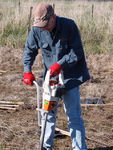PHYTOREMEDIATIONPhytoremediation involves the use of plants for the reclamation of soils or waterways that have been polluted by industrial contaminants such as metals, pesticides, solvents and hydrocarbons. It is a much more environmentally friendly way of mitigating the presence of harmful contaminants in soils or water than traditional methods such as the physical removal of soils via excavation. The main reason for this is that the remediation of contaminants is carried out in situ via the use of plants, with minimal disturbance to the contaminated soil profile. Where excavation of contaminated soils incurs considerable costs, using plants to effectively reclaim the soil without disturbing or removing it is much more economical by comparison. In biological terms the plants used in most phytoremediation projects are referred to as hyperaccumulators, which is a term used to describe any plant that has the ability to absorb contaminants to a higher concentration than the surrounding medium and degrade, fix or render such harmful substances benign. Phytoremediation is an emerging industry in many other countries and is still in its infancy in Australia. Research into native Australian grasses as well as some eucalyptus species suggests that many native and even locally indigenous plants are suitable for using in phytoremediation projects. Ecorepair is excited and proud to be involved with this emergent technology in the Australian context.
ART AND ENVIRONMENTAL PROBLEM SOLVING Eco Repair offers services to take contaminated areas and transform them from poor degraded sites into rich aesthetic and meaningful places by employing phytoremediating plant-based environmental art. Once again, this demonstrates to industry, government and community a visionary approach environmental responsibility.
Artists around the world have been involved in ecological problem-solving projects for the past 50 years. There are many benefits to enlarging the scope of an environmental regeneration project to that of an artwork, among those: - It becomes viewed as positive cultural contribution and engages a wider sector of the community.
- It adds aesthetic, meaningful and financial value to a site.
- Demonstration to industry, government and community a visionary approach environmental responsibility.
Outcomes of art-based ecologically regenerative projects are increasingly recognised and awarded in an international context.
PLANT-BASED ENVIRONMENTAL ARTThere are many names that describe the making of artworks out in the landscape from the materials of nature. Environmental Art and Land Art are two of the most commonly used terms. Plant based environmental art will use plants as the feature material for the artwork. Sculpted earth forms or contrived planting schemes may constitute the form of these artworks. Though it may employ similar approaches to landscape gardening, plant-based environmental art differs, as it aims to bring new layers of meaning and culture to a given site. The intention is for the viewer to be inspired to consider the space and place in new ways. Through Eco Repair, Artist Joanne Mott can be commissioned to develop and construct small or large-scale environmental artworks with plants and a variety of materials.
COMMUNITY COLLABORATIONArts capacity to incite awareness and social change has long been recognised. Expanding community stewardship is a key objective in making environmental artworks. The team at Eco Repair includes experienced facilitators to engage in community and education projects. This may include community participation ranging from tree-planting workshops to making large-scale environmental artworks.
BIO: JOANNE MOTTJoanne Mott has been a practising artist for the past 20 years. Her contemporary artworks may be described as Plant-based Sculpture, Environmental Art, Land Art and Site-specific Sculpture. With an emphasis on sustainability and resourcefulness, her work is informed by an interest in the layers of meaning and history embedded in any particular place. Inspired by the ways in which ?art? and ?the everyday? can entwine, she employs the language of gardens as a medium to express this idea. The nature of her large-scale sculptures invites an interactive experience for the viewer, driven by the ?spirit of place?. Multi-faceted research of a given site is undertaken in the process of developing her artworks, which encompasses recent and ancient uses of land, flora and fauna. The information gleaned, along with the site?s current functions inform the artwork?s meaning. Additionally, Mott looks to the grand designs of European gardening traditions for inspiration. Consequentially, her artworks speak of the rich and complex relationships of nature and culture in Australia today. She holds Masters of Fine Art (Monash University) and has a Certificate IV in Vocational Education and Training. She also has ten years? experience working in horticulture, specifically indigenous bush management in Australia. She is represented by MARS Gallery, Melbourne. For the past 3 years Mott has been facilitating outdoor sculpture projects around Victoria, Australia. Her experience and skills in relation to art projects include devising concepts, designs, construction plans and learning programs.
LINKSwww.joannemott.com www.marsgallery.com.au www.greenmuseum.org
BIO: JAMES BEATTIEJames Beattie is a professional horticulturist and garden writer working in Melbourne, Victoria. He is a graduate of Burnley College and currently works in bushland management, garden writing and landscape design. James enjoys everything garden-related, from working in his own and designing others gardens to writing about the horticultural issues of the day. He has a keen interest in using the aesthetics of garden design to achieve economic benefits and energy savings for households as well as businesses. James spends a lot of time in Melbourne's surrounding bushland and is a passionate advocate for habitat management and conservation of remnant bushland. He is a regular contributor to the gardening website gardendrum.com as well as other minor publications. | 







